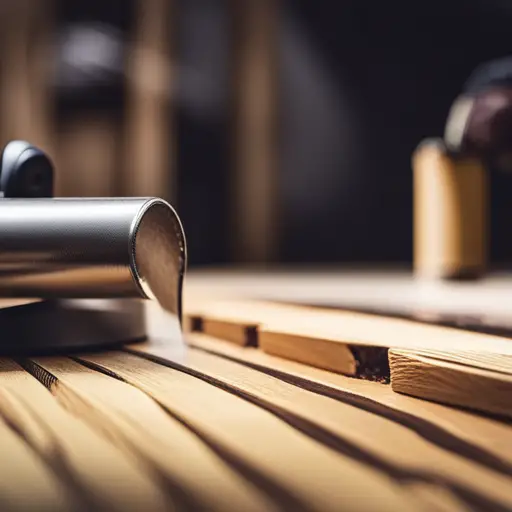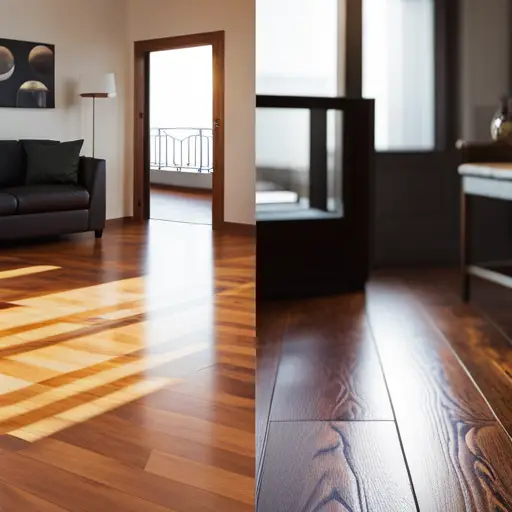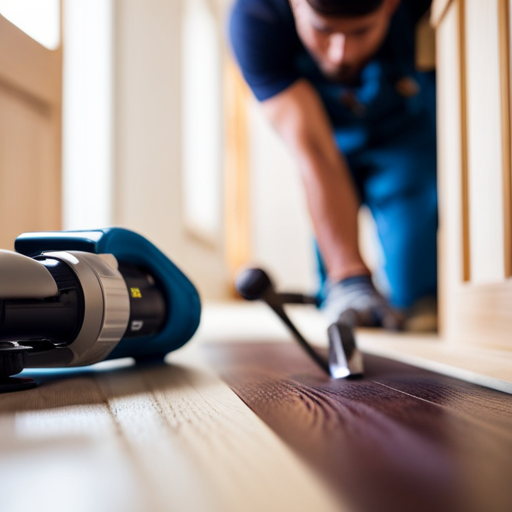Repairing Scratches and Dents in Wooden Floors

Every step taken on a wooden floor tells a story, but sometimes those stories include scratches and dents. In this comprehensive guide, we will explore the art of repairing these blemishes, ensuring that your wooden floors maintain their natural beauty and longevity.
From assessing the damage to applying the right repair solution, this article will provide you with the knowledge and expertise needed to restore your floors to their former glory.
Assessing the Damage
When assessing the damage to wooden floors, it is important to carefully examine both the depth and the extent of the scratches and dents. To assess the depth of the damage, one can run a fingertip over the scratch or dent. If the scratch is only on the surface and can barely be felt, it is likely a minor issue. However, if the scratch is deep and can be felt easily, it may require more extensive repair.
The extent of the damage refers to the area that has been affected. This can be determined by visually inspecting the scratch or dent and checking if it has affected the surrounding area.
Assessing techniques for wooden floor damage also involve identifying the type of wood and finish used. Different wood types and finishes may require different repair methods. Moreover, understanding the cause of the damage, whether it’s from furniture, pet claws, or heavy objects, is crucial in determining the appropriate repair options.
Understanding the depth, extent, type of wood, finish, and cause of the damage is essential in choosing the right repair method for wooden floors.
Choosing the Right Repair Method
To effectively address scratches and dents in wooden floors, it is imperative to carefully select the most appropriate repair method based on the specific characteristics of the damage. When it comes to repairing scratches, the method chosen should depend on the depth and severity of the scratch. Light surface scratches can often be addressed with simple touch-up kits or markers, while deeper scratches may require more extensive methods such as sanding and refinishing. On the other hand, filling dents in wooden floors requires a different approach. Small dents can often be filled with wood filler and sanded down to create a smooth surface, while larger dents may need more intricate techniques such as steaming or replacing the damaged board entirely.
The table below provides a concise overview of the key considerations when choosing a repair method for scratches and dents in wooden floors:
| Consideration | Repairing Scratches | Filling Dents |
|---|---|---|
| Depth of Damage | Light scratches vs. deep scratches | Small dents vs. large dents |
| Required Materials | Touch-up kits, markers, sanding | Wood filler, sanding, steaming |
| Complexity of Method | Simple touch-ups vs. refinishing | Filling and sanding vs. board replacement |
Carefully considering these factors will ensure that the chosen repair method effectively addresses the specific scratches and dents in wooden floors, leading to a successful restoration of the floor’s appearance and integrity.
Gathering Necessary Materials
The next step in the process of repairing scratches and dents in wooden floors is to gather the necessary materials to carry out the selected repair method effectively. To accomplish this, you will need:
-
Wood Filler Application and Sanding:
- Quality wood filler that matches the color and grain of the damaged wood.
- Sandpaper with different grits for both initial sanding and fine sanding. This ensures a smooth and level surface.
-
Stain Matching and Finishing Techniques:
- Stain that closely matches the existing floor finish to seamlessly blend the repaired area with the surrounding floor.
- Protective finish such as polyurethane or varnish to provide durability and aesthetic continuity.
Preparing the Damaged Area
After gathering the necessary materials for repairing scratches and dents in wooden floors, the next step involves preparing the damaged area for the repair process. Assessing techniques are crucial in this phase.
Firstly, it’s essential to clean the damaged area thoroughly to remove any dirt, dust, or debris. This can be done using a soft brush or a vacuum cleaner. Once the area is clean, it’s important to assess the extent of the damage. For scratches, the depth and length should be carefully examined to determine the best course of action.
In the case of dents, the surrounding wood should be checked for any signs of splintering or cracking. After assessing the damage, the repair preparation can begin. This may involve sanding the damaged area to create a smooth surface for the repair materials to adhere to.
In some cases, wood putty or filler may be needed to fill in deep scratches or dents. By meticulously preparing the damaged area, the subsequent repair process will be more effective and yield better results.
Applying the Repair Solution
To effectively address scratches and dents in wooden floors, the next step involves applying the appropriate repair solution to the prepared damaged area.
-
Application Process: Carefully apply the chosen repair solution to the damaged area, ensuring that it fills scratches and dents adequately. Use a small brush or a clean, soft cloth to rub the solution into the damaged area, following the direction of the wood grain for a seamless finish.
-
Finishing Touches: Once the repair solution is applied, carefully wipe off any excess to ensure a smooth and even surface. Allow the solution to dry completely as per the manufacturer’s instructions before proceeding to the next step.
-
Effectiveness and Long-Term Durability: Assess the effectiveness of the repair solution in addressing the scratches and dents. Consider the long-term durability of the solution and its ability to withstand regular foot traffic and daily wear and tear. A high-quality repair solution should blend seamlessly with the existing floor, providing a durable and long-lasting finish.
Applying the repair solution is a crucial step in restoring the wooden floor’s appearance and integrity, and attention to detail during this process is essential for achieving a professional result.
Sanding and Refinishing
Following the application of the repair solution, proceed with the next step by carefully sanding and refinishing the treated area to restore the wooden floor’s original smooth and polished appearance.
Begin by sanding the repaired area using a fine-grit sandpaper to ensure a level surface. This will also help to blend the treated area with the surrounding floor.
After sanding, ensure that the dust and debris are thoroughly removed from the area.
Once the surface is smooth, it’s time to match the stain color with the rest of the floor. Test the stain on a small, inconspicuous area to ensure it matches perfectly.
Apply the stain evenly to the sanded area and allow it to dry completely. This step is crucial for achieving a seamless finish.
After the stain has dried, apply a protective varnish to the entire treated area. Use a brush or applicator pad to ensure an even application.
The varnish not only protects the wood but also gives it a glossy, polished look. Allow the varnish to dry completely before walking on the repaired area.
Sanding and refinishing are essential steps in restoring the beauty of your wooden floor while ensuring a durable and long-lasting repair.
Maintaining and Preventing Future Damage
To ensure the longevity of wooden floors, it is essential to implement preventive measures against future damage.
This includes regular maintenance routines such as sweeping, vacuuming, and using floor protectors under furniture.
Additionally, understanding the specific care requirements for wooden floors, such as avoiding excessive exposure to water and using the appropriate cleaning products, can significantly contribute to their preservation.
Preventing Future Floor Damage
Proper maintenance is essential for preventing future damage to wooden floors. To ensure the longevity of your floors, consider these key practices:
-
Regular maintenance: Implement a routine cleaning schedule to remove dirt and debris that can scratch the surface of the wood. Use a soft-bristled broom or a vacuum with a floor-brush attachment to gently remove dust and dirt. Additionally, wipe up spills promptly to prevent moisture from seeping into the wood and causing damage.
-
Protective coatings: Apply a protective sealant or wax to create a barrier against scratches and dents. This coating acts as a shield, safeguarding the wood from everyday wear and tear. Ensure that the coating is applied evenly and reapplied as needed to maintain its protective qualities.
-
Furniture pads: Place felt or rubber pads on the bottom of furniture legs to prevent scratches and dents caused by movement or weight. These pads provide a cushioned barrier between the furniture and the wooden floor, reducing the risk of damage.
Maintenance Tips for Floors
For optimal floor maintenance and to prevent future damage, consider incorporating protective coatings, regular cleaning, and furniture pads as part of your routine care for wooden floors.
Protective coatings such as polyurethane or wax can help shield the wood from scratches and dents, while also providing a polished finish.
Regular wood floor cleaning is essential to prevent dirt and debris from accumulating and causing abrasions. Use a soft-bristled broom or a vacuum with a floor-brush attachment to remove dust and grit.
Additionally, placing furniture pads under the legs of tables, chairs, and other heavy items can prevent scratches and dents caused by movement.
By implementing these maintenance practices, you can extend the lifespan of your wooden floors and keep them looking their best.
Transition: Now, let’s delve into the specifics of wooden floor care.
Wooden Floor Care
Implementing protective coatings, regular cleaning, and furniture pads is crucial for maintaining wooden floors and preventing future damage.
-
Protective Coatings: Applying a protective sealant or wax creates a barrier against moisture, scratches, and wear. This safeguards the natural beauty of the wood and prolongs its lifespan.
-
Regular Cleaning: Routine sweeping and mopping with a damp, not wet, cloth helps to remove dust, dirt, and debris that can cause abrasions. Using a pH-neutral wood floor cleaner ensures gentle yet effective maintenance.
-
Furniture Pads: Placing felt or rubber pads under furniture legs prevents scratches and dents caused by movement. It also minimizes the risk of scraping the floor’s surface.
In addition to these measures, periodic wood polish application can enhance the floor’s luster and provide an extra layer of protection against everyday wear and tear.
Frequently Asked Questions
Can I Use Household Items to Repair Scratches and Dents in My Wooden Floors?
DIY methods can be effective for minor scratches and dents in wooden floors, using household items like vinegar, olive oil, or walnuts. However, for severe damage, professional restoration services are recommended for a more comprehensive and lasting solution.
What Should I Do if the Damage to My Wooden Floor Is Extensive and Beyond DIY Repair?
In cases where extensive damage to a wooden floor surpasses DIY repair, professional restoration is essential. An expert restoration service will assess the damage, provide a detailed repair cost estimation, and execute meticulous repairs to restore the floor’s integrity.
Are There Any Long-Term Effects of Not Repairing Scratches and Dents in Wooden Floors?
Neglecting to repair scratches and dents in wooden floors can lead to long-term negative effects such as increased susceptibility to moisture damage, wear, and tear. Implementing preventative measures can mitigate these issues, preserving the floor’s integrity.
How Often Should I Inspect My Wooden Floors for Potential Damage?
Regular maintenance of wooden floors is essential to ensure longevity and prevent costly damage. Professional inspections should be conducted annually to identify potential issues early. Both practices are crucial for preserving the quality of wooden floors.
Is There a Specific Type of Wood Floor That Is More Prone to Scratches and Dents?
When considering wood floor durability and maintenance, it’s important to recognize that certain wood types are more prone to scratches and dents. Preventing such damage requires diligent care and maintenance practices.
Conclusion
In conclusion, repairing scratches and dents in wooden floors requires a thorough assessment of the damage, careful selection of the appropriate repair method, and the use of quality materials. By following proper preparation and application techniques, one can effectively restore the appearance of wooden floors.
Adding a protective finish can help maintain the floor’s integrity and prevent future damage. Just as a well-maintained floor can enhance the overall aesthetic of a space, taking care of oneself can lead to a more fulfilling and harmonious life.

Rubin Everest, a seasoned expert in the world of flooring, brings a wealth of knowledge and passion to the surface. As the mind behind ebbow.com, Rubin is dedicated to sharing insights on the latest trends, innovative solutions, and expert advice in the realm of flooring. Whether you’re seeking practical tips for installation or design inspiration, Rubin Everest is your go-to source for all things flooring-related, making your journey to the perfect floor an informed and enjoyable experience.





